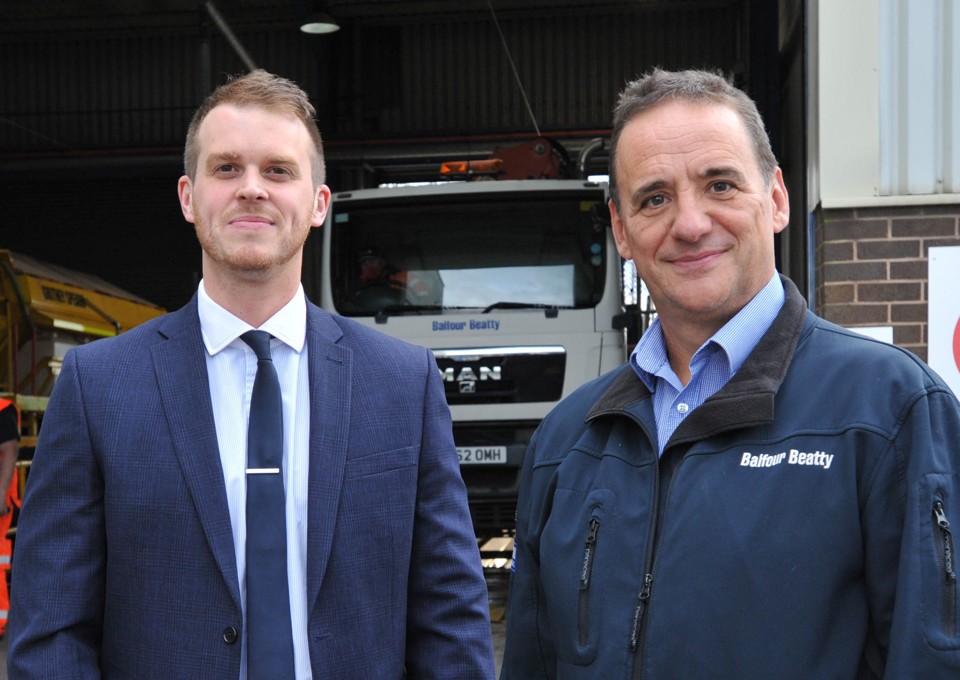The term Zero Harm has become a ubiquitous description of fleet ambitions to eliminate crashes when driving for work that result in death or injury, either to employees or the public.
The phrase was conceived by Balfour Beatty back in 2008 as a succinct way to define its risk management strategy: Zero Harm has since been adopted by dozens of fleets of all sizes to express their own commendable aspirations.
Over the past 15 years, Balfour Beatty has implemented a series of initiatives as part of its Zero Harm roadmap which has resulted in an impressive 65% reduction in at-fault incidents across cars, LCVs and HGVs since 2011.
Its incident rate, standing at just 4%, substantially below the industry average of 25-30%, reveals how close Balfour Beatty is getting to eliminating at-fault crashes.
Zero Harm remains central to the fleet strategy, ingrained in the business culture, but has more recently been integrated with the company’s sustainability policy, according to Chris Dickinson, fleet services director at Balfour Beatty Asset and Technology Solutions.
“Our objective as an internal fleet provider is to provide a safe and sustainable fleet which gives our customers the tools to complete their job,” he says, with ‘customers’ referring to the Balfour Beatty divisions served by the fleet team.
Dickinson joined Balfour Beatty as a business graduate with the group’s Rail business in 2008 and worked in a variety of operational roles before moving to the fleet team in 2017. He was promoted to his current position in July 2023.
Eighteen months ago, the division was renamed from Plant and Fleet Services to Asset and Technology Solutions (ATS) to better reflect the wide range of assets and services delivered across the group by the 500+ team in ATS.
Dickinson’s fleet services senior team numbers six, with a wider team of more than 100 fleet experts across the business: senior strategic fleet business partner David Shardlow, senior operations manager Stefan Smedley, driver risk operations manager Russ O’Neill, group transport compliance manager Adrian Wanford, head of operations Scotland Alan McCorquodale and administrator manager Kirsty Swinfield.
Video
Outsourced cars and LCVs
Ten years ago, Balfour Beatty surprised many in the fleet sector by outsourcing fleet supply and management services for all its cars and LCVs to experts Lex Autolease, retaining in-house control for the “strategic and complex” HGV fleet.
Until that point, most outsource contracts tended to focus on cars, with LCVs deemed mission critical and remaining under the management of a dedicated fleet or transport decision-maker. However, Balfour Beatty believed the two asset types could be treated the same for fleet management purposes, as long as it retained its grip on risk management and duty of care.
Lex Autolease is responsible for the in-life management of the 4,200 cars and 2,100 LCVs, including maintenance and 24/7 breakdown cover. It has a dedicated Balfour Beatty team working on the account.
Dickinson manages the strategic Lex relationship, with success measured via 48 KPIs across the end-to-end asset lifecycle (quote, order, supply, in life, accident management). Financial penalties apply should Lex fail to meet them; however, they have yet to be applied.
As a clear indication of the partnership’s achievements, the contract has just been extended for another three years, to 2026, with an option of a further two years.
“The KPIs are submitted monthly, and we review them with our dedicated account manager,” says Dickinson. “We also hold an annual strategic review to identify improvement areas and ideas around mutually beneficial growth and value adding activities. One example of this is the introduction of a reciprocal arrangement on service, maintenance and repair. We get the SMR business for any vehicle that is within 10 miles of one of our seven workshops after becoming one of Lex’s approved suppliers.”
The fleet services team manage the seven workshops, as well as one bodyshop, 17 mobile units, and the engineering innovation team which oversees bespoke requirements including vehicle modifications, review and implementation of new technology and vehicle specs and root cause analysis and investigations of incidents.
Balfour Beatty’s much feted risk strategy has three strands - vehicles, governance and drivers - and sits under the control of Wanford, the O-Licence holder.
It is rooted in the permit to drive, introduced in 2009, which includes all 13,000 drivers, from cars to HGVs. It integrates licence checks, desktop risk assessments with hazard perception, eLearning modules and bespoke training for any driver identified as high risk by the permit to drive system scoring outputs.
All new starters undergo induction training with minimum updates every three years. A team of eight delivers on-road coaching, CPC courses and safety presentations while managing the data that comes from the telematics and camera technology.
Every vehicle is fitted with an extensive list of mandatory safety equipment with clear operator guidance for each asset type.
“As well as telematics for our own fleet, we also have a ‘plug and play’ system for our external hires – around 1,000 LCVs and HGVs – which we introduced two years ago. We need to capture data from all our commercial vehicles and driver population to ensure we can eliminate driver risk across the entire business,” Dickinson says.
He adds: “We’re taking our telematics solution to the next level having had forward-facing dashcams as an option for the past two years. We’ve trialled connected camera with AI technology for the past 12 months on strategic contracts across the country with great feedback and we now plan to roll this out across our high-risk vehicles.”
The AI monitors fatigue and distraction levels and provides seatbelt and mobile phone usage alerts – it is currently being rolled out across 100 HGVs.
Driver risk management forum
In September 2023, Balfour Beatty held its fourth driver risk management forum, with a focus on safe and sustainable innovation.
It was attended by 55 employees, selected for their influence in managing risk, who undertook nine activities, including safe loading and loaded braking, HGV demonstrations, EV telematics and AI cameras.
“The purpose of the day was for us to share best practice, increase awareness of the ‘current’ and new driver/operator risks pertinent to the group, and get drivers’ views on the new AI cameras and safety equipment,” says Dickinson.
The work of the driver risk management team is complemented by Wanford’s compliance team of 13 staff and three regional transport managers. They are custodian of the O-Licence and undertake the annual FORS and Van Excellence accreditation audits.
On a day-to-day basis Wanford’s team are deployed at operational depots across the UK managing and overseeing driver’s hours and tachograph, driver briefings and training, maintenance planning and documentation retention, site-based vehicle roadworthiness, weight and documentation checks together with safety stand down event support.
“We visit sites every day giving toolbox talks, weighing vehicles, checking compliance; we do 2,500 random stops per year,” Wanford says. “We got all our Operator Compliance Risk Scores (OCRS) areas into green in 2015/16 and they have stayed there ever since.”
One issue, affecting many operators, is overloading. Wanford addressed it through the purchase of portable weight pads used by his team as both enforcement and educational tools supported by ongoing driver education to ensure they fully understood the risks. Balfour Beatty has also installed onboard weight indicators on all vehicles from 2.8 tonnes upwards.
Supporting compliance is a new pre-check app that links to the tacho data and enables the team to group vehicles by general spec, for example gritters. As well as the universal check sheet, Balfour Beatty can build in specific equipment, such as ancillary kit, based on the vehicle registration, making the app bespoke for each vehicle type.
Wanford says: “One benefit of the app is reduced admin because everything is auto filed. We have instant visibility of the driver report and check sheet to email to the line manager highlighting any defect reported so we can react immediately.”
The app has been rolled out across the fleet over the past two years, starting with HGVs and now LCVs.
The data sits with a new control hub in Derby, introduced earlier this year. An integrated hub that aligns the customer support teams for the HGVs, it enables an effective downtime management process by bringing together the maintenance, workshop and rental teams.
The support team handled 41,000 calls for the first nine months of 2023, organising 2,200 hires of cars, LCVs and HGVs, managing 1,000 vehicles and assets for maintenance and completing 15 workshop audits.
Already this year, the new hub has reduced vehicle off-road times by 2%, which on a fleet the size of Balfour Beatty adds up to a saving of tens of thousands of pounds, while maintenance and damage spend has been reduced by £30,000.
Balfour Beatty also has a 100% HGV MOT pass rate thanks to the robust maintenance regime via its IRTE-accredited workshops and technicians.
Already FORS Bronze, Balfour Beatty will go for the DVSA Earned Recognition (ER) scheme next year. It has already upgraded the Civica Tranman fleet management system with the appropriate ER module, which incorporates maintenance control, scheduling and workshop inventory, in preparation.
Becoming a zero-emission fleet
With sustainability rising to the top of its agenda, Balfour Beatty already has 88% of its cars ‘alternatively fuelled’ - a mix of job need and perk which play an important role in recruitment and retention. Full battery electric vehicles (BEVs) account for 15% of the total.
The choice list contains 46% BEV models with the rest PHEV plus a few self-charging hybrid options to ensure those without access to charging facilities are still supported. It is updated every quarter with more full electric models added each time.
By the start of 2025, Dickinson predicts the entire company car choice list will be fully electrified, with derogations for those who require an alternative due to a set list of criteria.
“Since we introduced more BEVs and PHEV, as well as industry changes (e.g increased residual values) we have seen some cash allowance takers move back into the company scheme to take advantage of improved BIK liability and fully supported vehicle provision,” Dickinson says. “We have around 1,500 employees who take cash and some 10% have come back into the car scheme over the last 18 months.”
The mandatory threshold for having a company car is 7,500 business miles per year. However, anyone taking cash and then driving their own car for business is still enrolled onto the permit to drive scheme.
Electrification of the van fleet will be a more protracted process with circa 2% of the 3,050 vehicles currently full electric. The aspiration is for the complete removal of diesel by 2030.
“We have 200 electric LCVs in the order bank so we will be around 10% by the end of next year,” Dickinson says.
“Our challenge is that, as a business, we are the ones building the infrastructure, which means there is no existing charging infrastructure where we work. We need a mobile solution.”
The first batches of full electric LCVs are earmarked for our local authority contracts which are back-to-base journeys taking place in and around towns and cities where the public charging network is more comprehensive.
HGVs, of course, present the biggest challenge of all. Balfour Beatty is undertaking a hydrogen retrofit project in Scotland with a dual-fuel hydrogen/diesel option, funded by the Scottish Government’s Emerging Energies Technology Fund. Its £240,000 investment is being matched by Balfour Beatty.
The first vehicles to be retrofitted are two gritters and two traffic management vehicles. They are due to be on the road by the end of the year and will provide a blueprint for the conversion of all Balfour Beatty HGVs. Each vehicle is expected to reduce carbon emissions by 40%.
Fleet to grow to more than 9,000 vehicles
Since 2018, Balfour Beatty’s car and van fleet size has increased by 30%, driven by contract wins. Dickinson is forecasting the fleet will exceed 9,000 vehicles next year based on anticipated business mobilisations.
Twenty per cent of the car fleet is external hires through preferred partners Europcar, Nexus and Enterprise. This provides cover for supply delays and new starters but is being reduced by around 1% a month with an ultimate target of 10-12%.
Balfour Beatty re-tendered its rental contract at the start of 2023 putting greater emphasis on having access to sustainable choices such as PHEV and full electric cars; now 10-15% of its hire cars are alternative fuels.
It also introduced an electric car salary sacrifice scheme in April. Open to all employees, it will have close to 100 cars on the road by the end of the year. The conversion rate on quotations is almost 50%, with the majority of uptake from staff not eligible for the company scheme.
Irrespective of asset type and usage, adherence to the robust risk management strategy will always stay top of Balfour Beatty’s priorities, just with the added spotlight on sustainability, according to Andy Ormerod, Balfour Beatty Asset & Technology Solutions managing director.
He said: “I’m really proud of what our fleet team delivers for our customers day in day out. From complex HGVs to substantial car and LCV fleet, the team always focus on delivering sustainable solutions ensuring our customers’ needs are met. The challenge of supporting the Balfour Beatty’s group targets of going beyond Net Zero by 2040 is being met by our early ordering of all electric LCVs and plans for our car choice list on track to turn all electric during 2025.”
FACTFILE
-
Fleet services director: Chris Dickinson
-
Appointed: July 2023
-
Fleet team: six direct reports, team of 104
-
Fleet size: 8,060 – 4,600 cars; 3,100 LCVs; 460 HGVs
-
Funding method: contract hire with maintenance
-
Operating cycle: cars – 4 years, LCVs – 4 or 5 years, HGVs – subject to customer requirement, contract duration and vehicle type, typically between 5 and 10 years
-
Workshops: eight























Login to comment
Comments
No comments have been made yet.